
ENGLISH
Introduction
Congratulations on your purchase and welcome to
Philips! To fully benet from the support that Philips offers,
register your product at www.philips.com/welcome.
General description (Fig. 1)
A Spout
B Lid latch
C Lid
D On/off switch (I/O) with power-on light
E Mains cord
F Cord storage facility
G Base
H Water level indicator
I Scale lter
Important
Read this user manual carefully before you use the
appliance and save it for future reference.
Danger
Do not immerse the appliance or the base in water
or any other liquid.
Warning
Check if the voltage indicated on the appliance
corresponds to the local mains voltage before you
connect the appliance.
Do not use the appliance if the plug, the mains cord,
the base or the appliance itself is damaged.
If the mains cord is damaged, you must have it
replaced by Philips, a service centre authorised by
Philips or similarly qualied persons in order to avoid
a hazard.
This appliance is not intended for use by persons
(including children) with reduced physical, sensory
or mental capabilities, or lack of experience and
knowledge, unless they have been given supervision
or instruction concerning use of the appliance by a
person responsible for their safety.
Children should be supervised to ensure that they
do not play with the appliance.
Keep the mains cord out of the reach of children.
Do not let the mains cord hang over the edge of
the table or worktop on which the appliance stands.
Excess cord can be stored in or around the base of
the appliance.
Keep the mains cord, the base and the kettle away
from hot surfaces.
Do not place the appliance on an enclosed surface
(e.g. a serving tray), as this could cause water to
accumulate under the appliance, resulting in a
hazardous situation.
Hot water can cause serious burns. Be careful when
the kettle contains hot water.
Do not touch the body of the kettle during and
some time after use, as it gets very hot. Always lift
the kettle by its handle.
Never ll the kettle beyond the maximum level
indication. If the kettle has been overlled, boiling
water may be ejected from the spout and cause
scalding.
Do not open the lid while the water is heating up or
boiling. Be careful when you open the lid immediately
after the water has boiled: the steam that comes out
of the kettle is very hot.
This rapid-boil kettle can draw up to 10 amps from
the power supply in your home. Make sure that the
electrical system in your home and the circuit to
which the kettle is connected can cope with this level
of power consumption. Do not let too many other
appliances draw power from the same circuit while
the kettle is being used.
Only use the kettle in combination with its original
base.
Caution
Do not connect the appliance to an external
switching device such as a timer and do not connect
it to a circuit that is regularly switched on and off by
the utility. This prevents a hazard that could be caused
by inadvertent resetting of the thermal cut-out.
Always place the base and the kettle on a dry, at
and stable surface.
The kettle is only intended for boiling water. Do not
use it to heat up soup or other liquids or jarred,
bottled or tinned food.
-
-
-
-
-
-
-
-
-
-
-
-
-
-
-
-
-
-
Never ll the kettle below the 1-cup level to prevent
it from boiling dry.
Depending on the hardness of the water in your
area, small spots may appear on the heating element
of your kettle when you use it. This phenomenon is
the result of scale build-up on the heating element
and on the inside of the kettle over time. The harder
the water, the faster scale builds up. Scale can occur
in different colours. Although scale is harmless, too
much scale can inuence the performance of your
kettle. Descale your kettle regularly by following the
instructions given in chapter ‘Descaling’.
Some condensation may appear on the base of the
kettle. This is perfectly normal and does not mean
that the kettle has any defects.
Do not operate the kettle on an inclined plane. Do
not operate the kettle unless the element is fully
immersed. Do not move while the kettle is switched
on.
To prevent damage to the appliance do not use
alkaline cleaning agents when cleaning, use a soft
cloth and a mild detergent.
Boil-dry protection
This kettle is equipped with boil-dry protection. This
device automatically switches off the kettle if it is
accidentally switched on when there is no water or not
enough water in it. Lift the kettle from its base and ll it
with water to reset boil-dry protection. The kettle is now
ready for use again.
Electromagnetic elds (EMF)
This Philips appliance complies with all standards
regarding electromagnetic elds (EMF). If handled
properly and according to the instructions in this user
manual, the appliance is safe to use based on scientic
evidence available today.
Before first use
1 Remove stickers, if any, from the base or the kettle.
2 Placethebaseonadry,atandstablesurface.
3 Toadjustthelengthofthecord,windpartofit
roundthereelinthebase.Passthecordthrough
oneoftheslotsinthebase.(Fig.2)
4 Rinsethekettlewithwater.
5 Fillthekettlewithwateruptothemaximumlevel
andletthewaterboilonce(seechapter‘Usingthe
appliance’).
6 Pouroutthehotwaterandrinsethekettleonce
more.
Using the appliance
1 Fillthekettlewithwater.Youcanllthekettle
eitherthroughthespoutorthroughtheopen
lid.(Fig.3)
To open the lid, pull at the lid latch (Fig. 4).
Fill the kettle with at least one cup (250ml) water.
Close the lid before you switch on the kettle.
Make sure that the lid is properly closed to prevent the
kettle from boiling dry.
2 Placethekettleonitsbaseandputthepluginthe
wallsocket.
3 Pushtheon/offswitchdownwardstoswitchonthe
appliance(Fig.5).
Thepower-onlightgoeson.
Thekettlestartsheatingup.
Thekettleswitchesoffautomatically(‘click’)when
thewaterboils.
Thepower-onlightgoesoutautomaticallywhen
thekettleswitchesoff.
Note: You can interrupt the boiling process at any time by
pushing the on/off switch upwards.
Cleaning
Neverusescouringpads,abrasivecleaningagentsor
aggressiveliquidssuchaspetroloracetonetocleanthe
appliance.
Neverimmersethekettleoritsbaseinwater.
1 Unplugtheappliance.
2 Cleantheoutsideofthekettlewithasoftcloth
moistenedwithwarmwaterandsomemild
cleaningagent.
3 Cleanthescalelterregularly.
-
-
-
-
-
-
-
-
,
,
,
,
Scale is not harmful to your health but it may give your
drink a powdery taste. The scale lter prevents scale
particles from ending up in your drink. Clean the scale
lter in one of the following ways:
Take the scale lter out of the kettle and gently clean
it with a soft nylon brush under a running tap. (Fig. 6)
Leave the scale lter in the kettle when you descale
the whole appliance.
Clean the scale lter in the dishwasher.
Descaling
Regular descaling prolongs the life of the kettle.
In case of normal use (up to 5 times a day), we
recommend the following descaling frequency:
Once every 3 months for soft water areas (up to
18dH).
Once every month for hard water areas (more than
18dH).
1 Fillthekettlewithapprox.400mlwater.
2 Switchonthekettle.
3 Afterthekettleswitchesoff,addwhitevinegar(8%
aceticacid)totheMAXindication.
4 Leavethesolutioninthekettleovernight.
5 Emptythekettleandrinsetheinsidethoroughly.
6 Fillthekettlewithfreshwaterandboilthewater.
7 Emptythekettleandrinseitwithfreshwateragain.
Repeat the procedure if there is still some scale in the
kettle.
Tip: You can also use an appropriate descaler. In that case,
follow the instructions on the package of the descaler.
Storage
1 Tostorethemainscord,winditroundthereelin
thebase(Fig.2).
Replacement
Ifthekettle,thebaseorthemainscordoftheappliance
isdamaged,takethebaseorthekettletoaservice
centreauthorisedbyPhilipsforrepairorreplacement
of the cord to avoid a hazard.
You can purchase a new lter (order number 4222 459
45326) at your Philips dealer or at a Philips service centre.
Environment
Do not throw away the appliance with the normal
household waste at the end of its life, but hand it in
at an ofcial collection point for recycling. By doing
this, you help to preserve the environment (Fig. 7).
Guarantee and service
If you need service or information or if you have a
problem, please visit the Philips website at www.philips.
com or contact the Philips Consumer Care Centre
in your country (you nd its phone number in the
worldwide guarantee leaet). If there is no Consumer
Care Centre in your country, go to your local Philips
dealer.
Tips
Save energy, only boil what you need
Filling your kettle completely to make just one or two
cups of tea wastes energy. This Philips kettle has a unique
1 cup indicator so you can easily see exactly how much
water you need. By only boiling the cup of water you
need you could save 66% energy!
-
-
-
-
-
-


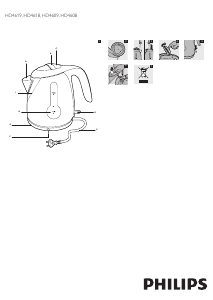

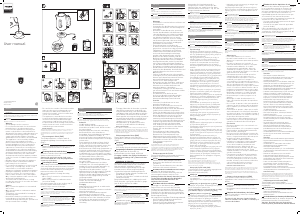
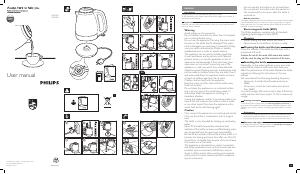
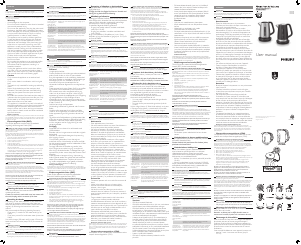
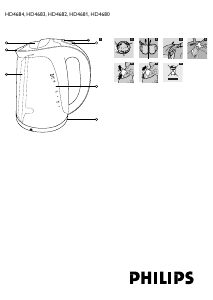
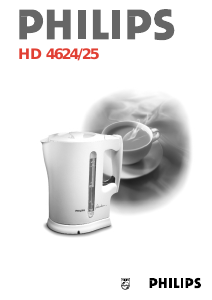
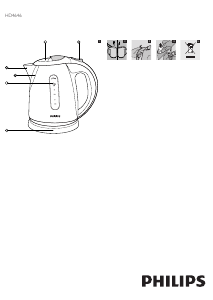
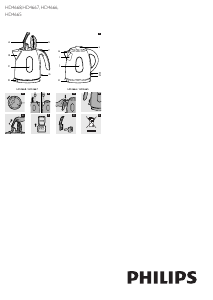
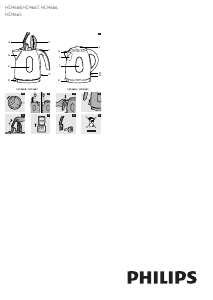
Participe da conversa sobre este produto
Aqui você pode compartilhar o que pensa sobre Philips HD4608 Jarro eléctrico. Se você tiver alguma dúvida, primeiro leia atentamente o manual. A solicitação de manual pode ser feita através do nosso formulário de contato.